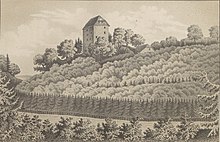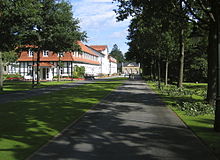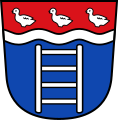Oeynhausen (noble family)
Oeynhausen is the name of an old Westphalian noble family . The Lords of Oyenhausen belonged to the ancient nobility in the Paderborn region . The spelling of the name varies from Oyenhausen , Oynhausen , Oinhausen , Öynhausen , Oenhausen to Oeynhausen . Branches of the family still exist today.
history
origin
In old annals the name Oeynhausen is interpreted as a single house. The family is first mentioned with Bernhardus villicus de Oienhusen in a document issued on May 1, 1237. Oeynhausen , the headquarters that gave it its name, is now a town near the town of Nieheim in the Höxter district . The uninterrupted tribe series begins around 1300 with Johann von Oynhausen .
Lines and possessions
From the middle of the 14th century until 1632 Merlsheim Castle was owned by the family. Johann, Konrad and the brothers Burchard and Friedrich von Oeynhausen appeared on the Lehentage of the Principality of Paderborn in 1500. From that time on the family spread to the surrounding countries. As early as 1430, the Lichtenau and Sudheim estates came into the possession or partial ownership of the family. From the 16th century until the early 18th century, Eichholz belonged to the family, who divided it into two estates in 1612. In 1536 Gut Grevenburg near Nieheim could be acquired, which still belongs to the Barons of Oeynhausen.
In 1592 the family acquired the Oldenburg near Marienmünster . Adam Arnd von Oeynhausen bought further fiefs from his brother-in-law Asmus von Baumbach in 1600 ; he died in 1635 as Burgmann zu Gießen. His son Heinrich Hermann († 1671) became a chamberlain in Darmstadt and a Brunswick landdrost and miner in 1641 . Georg von Oeynhausen was an imperial colonel around 1630 and, like Melchior Hermann von Oeynhausen, ducal-Holstein colonel, distinguished himself during the Thirty Years' War . Arnd von Oeynhausen, lord of Gut Grevenburg, was a captain and commander in Gießen in 1650 . Raban Arnold von Oeynhausen acquired the Nordling desert from the Schencken zu Schweinsberg in 1665 as a fief of the Fulda Abbey . Friedrich von Oeynhausen was one of the canons of Paderborn in 1702 . Later, individual branches of the family became, among others, Langreder in the Calenberger Land and, more recently, Brahlstorf near Wittenburg in Mecklenburg-Schwerin.
The Lords of Oeynhausen belonged to the knightly nobility in the Calenberger Land early on . During the 18th century they were also members of the imperial knighthood in the Rhenish knight circle .
The Magdeburg canon Count Ludwig Ferdinand von Oeynhausen, grandson of the first Count of Oeynhausen Raban Christoph and his wife Sophia Juliana von der Schulenburg , was adopted by an uncle on his mother's side in 1725 and called himself Count von der Schulenburg-Oeynhausen. He later became Imperial Colonel and was promoted to Major General in 1735. The count's trunk established two lines and the first line again three branches.
The progenitor of the first branch of the first line was the Kurhannoversche Oberjäger and forester Friedrich Ulrich Graf von Oeynhausen, Lord of Grevenburg, Reelsen and Dören.
The second branch was founded by Count Julius von Oeynhausen, son of the Electorate of Hanover, Count Ludwig von Oeynhausen.
The third branch of the first line is characterized as the Portuguese-Brazilian branch in particular by Johann Carl August von Oeynhausen-Grevenburg (* 1777 or 1778, probably in Lisbon), last Captain General of São Paulo (1819-1821), multiple minister (1827-1831, Foreign Affairs and Navy) under the Brazilian Emperor Dom Pedro I and most recently Portuguese Governor of Mozambique (1837–1838). He was later appointed Marquez de Aracaty. He was the son of Count Carl August von Oeynhausen (born November 5, 1738, † March 3, 1793). His mother is unknown, he was raised by his stepmother, Leonor de Almeida Portugal Lorena y Lencastre , the 4th Marqueza de Alorna (1750-1839, married to his father since 1779). His stepbrother Johann Carl Ulrich (* 1779) inherited the title of count from his father. Johann Carl August von Oeynhausen-Grevenburg died on March 28, 1838, without leaving any descendants.
The second count's line is extinguished. The last member of the family was Count Ferdinand Ludwig (II.) Von Oeynhausen, chamberlain to the Princely Lippe region († 1860).
In Reelsen , where previously there was only an administrator's house, a new mansion was built outside the village in 1871. A younger son from Reelsen, Count Cuno von Oeynhausen (1860–1922), married Hedwig Freiin von Cramm-Sierstorpff (1874–1907), the heiress of the Driburg Fideikommisses (1874–1907) and from 1909 was named Graf von Oeynhausen-Sierstorpff with imperial approval . By marrying into the Cramm family , this branch of the family took over the Driburg spa, founded in 1784 by Kaspar Heinrich von Sierstorpff . The descendants still run the Graeflicher Park Bad Driburg health clinic to this day .
Status surveys
The royal British chamberlain and chief hunter in the Electorate of Hanover Raben Christoph von Oeynhausen was appointed by Emperor Karl VI. April 17, 1722 Vienna into the imperial counts charged. The survey was recognized and announced on August 14, 1725 in Hanover. He and his wife Margarethe, geb. Freiin von der Schulenburg, her loyal service to the sovereign, Elector Georg I. Ludwig , because they had officially brought up the daughters who came from the liaison of their sister or sister-in-law Melusine von der Schulenburg with the future British king as their own children.
In order to be able to be married appropriately, the foster daughter Margarete Gertrud von Oeynhausen was given the count status as early as October 10, 1721 with the salutation high and well-born and an increased coat of arms with that of von der Schulenburg. In the same year, on September 30, she married the Hereditary Count Albrecht Wolfgang zu Schaumburg-Lippe , the ambassadors of Hanover and Great Britain at the Palatinate Court in Mannheim.
Other branches of the sex bore the baron title under customary law . A Prussian recognition of the baron class took place on April 28, 1874 by the highest cabinet order .
coat of arms
The family coat of arms shows an upright silver ladder with four rungs in blue. On the crowned helmet two outwardly sloping silver ladder trees with four outward facing rungs (half ladders). The helmet covers are blue-silver.
In later illustrations, a blue flight appears as a crest ornament , with each wing being covered with one of the ladder trees.
The ladder from the coat of arms of the Oeynhausen family still appears today in the city coat of arms of Bad Oeynhausen , where the tinging is silver and white.
Coat of arms (1721) Countess Margarethe Gertrud von Oeynhausen, wife of Albrecht Wolfgang Graf zu Schaumburg-Lippe
Name bearer
- Adolf von Oeynhausen (* 1877, † 1953), German government official and SS leader
- Friedrich von Oeynhausen (* 1801; † 1875), Hanoverian major, Mecklenburg landowner and politician
- Georg Ludwig von Oeynhausen (* 1734; † 1811), Hanoverian lieutenant general
- Karl von Oeynhausen (* 1795; † 1865), Prussian mining captain, namesake of Bad Oeynhausen
- Countess Oeynhausen-Schulenburg, namesake of Oeynhausen in Lower Austria (founded around 1770)
See also
literature
- Julius Graf von Oeynhausen: History of the family of Oeynhausen , 4 volumes / 1870–1889 (online: Google Books , ULB Münster , digitized version )
- Genealogical manual of the nobility . Nobility Lexicon . Volume IX (volume 116 of the complete series). CA Starke Verlag, Limburg (Lahn) 1998, ISSN 0435-2408
- Otmar Falkner: The one from Oeynhausen at the Bosenhof . In: Contributions to Westphalian family research , Vol. 59/2001, pp. 246–261.
- Otto Hupp : Munich calendar 1919. Buch u. Art Print AG, Munich / Regensburg 1919.
- Karsten Kelberg: The von Oeynhausen family and their coat of arms. In: Johannes Henke (Ed.): 150 Years of the Oeynhausen Spa. Horb am Neckar 1998, pp. 198-206. ISBN 3-89570-387-7
- Oynhausen . In: Heinrich August Pierer , Julius Löbe (Hrsg.): Universal Lexicon of the Present and the Past . 4th edition. tape 12 . Altenburg 1861, p. 540 ( zeno.org ).
- Bernhard von Poten : Oeynhausen, Ferdinand Ludwig Graf . In: Allgemeine Deutsche Biographie (ADB). Volume 25, Duncker & Humblot, Leipzig 1887, pp. 28-30.
- Bernhard von Poten: Oeynhausen, Georg Ludwig Graf . In: Allgemeine Deutsche Biographie (ADB). Volume 25, Duncker & Humblot, Leipzig 1887, p. 30 f.
- Oeynhausen. In: New general German nobility lexicon . 6th volume. Leipzig 1865, pp. 585-587 ( digitized version ).
Web links
- Description of the moated castle Thienhausen in www.welt-der-wappen.de
- Document registers from the archive of Gut Grevenburg / digital Westphalian document database (DWUD)
- Coat of arms of the Oeynhausen in the coat of arms of the Westphalian nobility
- United Westphalian Adelsarchive eV
Individual evidence
- ^ Regest of an Abdinghofer deed in Overham's manuscripts, Wolfenbüttel city archive I, 2.
- ^ Gerhard Köbler : Historical Lexicon of the German Lands. The German territories from the Middle Ages to the present. 7th, completely revised edition. CH Beck, Munich 2007, ISBN 978-3-406-54986-1 .
- ↑ Friedrich Sommer: German character pictures from Brazilian history. Verlag Rotermund & Co., São Leopoldo n.d. [after 1916], pp. 62–68 ( Johann Carl August von Oeynhausen ).
- ↑ Ulrike Weiß, Dame Herzog: Elector King. The house of the Hanoverian Guelphs 1636–1866. in the series of writings of the Historisches Museum Hannover , vol. 34, Hannover 2008, p. 105.
Coordinates: 51 ° 48 '47.8 " N , 9 ° 3' 7.4" E







